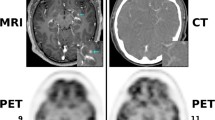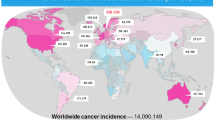Abstract
Purpose
The purpose of this study was to evaluate the impact of PET/CT on clinical management of cancer patients based on a prospective data registry. The study was developed to inform consultations with public health insurances on PET/CT coverage.
Methods
We evaluated a prospective patient cohort having a clinically indicated PET/CT at a single German University Center from April 2013 to August 2016. The registry collected questionnaire data from requesting physicians on intended patient management before and after PET/CT. A total of 4,504 patients with 5,939 PET/CT examinations were enrolled in the registry, resulting in evaluable data from 3,724 patients receiving 4,754 scans. The impact of PET/CT on patient management was assessed across 22 tumor types, for different indications (diagnosis, staging, suspected recurrence) and different categories of management including treatment (curative or palliative) and non-treatment (watchful waiting, additional imaging, invasive tests).
Results
The most frequent PET/CT indication was tumor staging (59.7%). Melanoma, lung cancer, lymphoma, neuroendocrine tumor and prostate cancer accounted for 70% of cases. Overall, the use of PET/CT resulted in a 37.1% change of clinical management (95% CI, 35.7–38.5), most frequently (30.6%) from an intended non-treatment strategy before PET/CT to active treatment after PET/CT. The frequency of changes ranged from 28.3% for head and neck cancers up to 46.0% for melanomas. The impact of PET/CT was greatest in reducing demands for additional imaging which decreased from 66.1% before PET/CT to 6.1% after PET/CT. Pre-PET/CT planned invasive tests could be avoided in 72.7% of cases. The treatment goal changed after PET/CT in 21.7% of cases, in twice as many cases from curative to palliative therapy than vice versa.
Conclusions
The data of this large prospective registry confirm that physicians often change their intended management on the basis of PET/CT by initiating treatment and reducing additional imaging as well as invasive tests. This applies to various cancer types and indications.





Similar content being viewed by others
References
Vach W, Hoilund-Carlsen PF, Gerke O, Weber WA. Generating evidence for clinical benefit of PET/CT in diagnosing cancer patients. J Nucl Med. 2011;52(Suppl 2):77S–85S. https://doi.org/10.2967/jnumed.110.085704.
Hoilund-Carlsen PF, Gerke O, Vach W. Demonstrating the benefits of clinical nuclear imaging: is it time to add economic analysis? Eur J Nucl Med Mol Imaging. 2014;41(9):1720–2. https://doi.org/10.1007/s00259-014-2807-6.
Gerke O, Hoilund-Carlsen PF, Vach W. Analyzing paired diagnostic studies by estimating the expected benefit. Biom J. 2015;57(3):395–409. https://doi.org/10.1002/bimj.201400020.
Czernin J, Allen-Auerbach M, Nathanson D, Herrmann K. PET/CT in oncology: current status and perspectives. Curr Radiol Rep. 2013;1:177–90. https://doi.org/10.1007/s40134-013-0016-x.
Hillman BJ, Frank RA, Abraham BC. The Medical Imaging & Technology Alliance conference on research endpoints appropriate for Medicare coverage of new PET radiopharmaceuticals. J Nucl Med. 2013;54(9):1675–9. https://doi.org/10.2967/jnumed.113.127886.
Hillman BJ, Gatsonis CA. When is the right time to conduct a clinical trial of a diagnostic imaging technology? Radiology. 2008;248(1):12–5. https://doi.org/10.1148/radiol.2481072190.
Staub LP, Dyer S, Lord SJ, Simes RJ. Linking the evidence: intermediate outcomes in medical test assessments. Int J Technol Assess Health Care. 2012;28(1):52–8. https://doi.org/10.1017/s0266462311000717.
Valk P. Randomized controlled trials are not appropriate for imaging technology evaluation. J Nucl Med. 2000;41:1125–6.
Merlin T. The use of the ‘linked evidence approach to guide policy on the reimbursement of personalized medicines. Personalized Medicine. 2014;11(4):435–48.
Siepe B, Hoilund-Carlsen PF, Gerke O, Weber WA, Motschall E, Vach W. The move from accuracy studies to randomized trials in PET: current status and future directions. J Nucl Med. 2014;55(8):1228–34. https://doi.org/10.2967/jnumed.113.127076.
Metser U, Dudebout J, Baetz T, Hodgson DC, Langer DL, MacCrostie P, et al. [(18) F]-FDG PET/CT in the staging and management of indolent lymphoma: a prospective multicenter PET registry study. Cancer. 2017;123(15):2860–6. https://doi.org/10.1002/cncr.30672.
Ryu IS, Roh JL, Kim JS, Lee JH, Cho KJ, Choi SH, et al. Impact of (18)F-FDG PET/CT staging on management and prognostic stratification in head and neck squamous cell carcinoma: a prospective observational study. Eur J Cancer. 2016;63:88–96. https://doi.org/10.1016/j.ejca.2016.05.002.
Lonneux M, Hamoir M, Reychler H, Maingon P, Duvillard C, Calais G, et al. Positron emission tomography with [18F]fluorodeoxyglucose improves staging and patient management in patients with head and neck squamous cell carcinoma: a multicenter prospective study. J Clin Oncol. 2010;28(7):1190–5. https://doi.org/10.1200/jco.2009.24.6298.
Barrio M, Czernin J, Fanti S, Ambrosini V, Binse I, Du L, et al. The impact of somatostatin receptor-directed PET/CT on the management of patients with neuroendocrine tumor: a systematic review and meta-analysis. J Nucl Med. 2017;58(5):756–61. https://doi.org/10.2967/jnumed.116.185587.
Kubota K, Matsuno S, Morioka N, Adachi S, Koizumi M, Seto H, et al. Impact of FDG-PET findings on decisions regarding patient management strategies: a multicenter trial in patients with lung cancer and other types of cancer. Ann Nucl Med. 2015;29(5):431–41. https://doi.org/10.1007/s12149-015-0963-9.
Kalff V, Hicks RJ, Ware RE, Hogg A, Binns D, McKenzie AF. The clinical impact of (18)F-FDG PET in patients with suspected or confirmed recurrence of colorectal cancer: a prospective study. J Nucl Med. 2002;43(4):492–9.
Herrmann K, Czernin J, Wolin EM, Gupta P, Barrio M, Gutierrez A, et al. Impact of 68Ga-DOTATATE PET/CT on the management of neuroendocrine tumors: the referring physician's perspective. J Nucl Med. 2015;56(1):70–5. https://doi.org/10.2967/jnumed.114.148247.
Calais J, Czernin J, Eiber M, Fendler WP, Gartmann J, Heaney AP, et al. Most of the intended management changes after (68)Ga-DOTATATE PET/CT are implemented. J Nucl Med. 2017;58(11):1793–6. https://doi.org/10.2967/jnumed.117.192450.
van Tinteren H, Hoekstra OS, Smit EF, van den Bergh JH, Schreurs AJ, Stallaert RA, et al. Effectiveness of positron emission tomography in the preoperative assessment of patients with suspected non-small-cell lung cancer: the PLUS multicentre randomised trial. Lancet. 2002;359(9315):1388–93.
Ruers TJ, Wiering B, van der Sijp JR, Roumen RM, de Jong KP, Comans EF, et al. Improved selection of patients for hepatic surgery of colorectal liver metastases with (18)F-FDG PET: a randomized study. J Nucl Med. 2009;50(7):1036–41. https://doi.org/10.2967/jnumed.109.063040.
Moulton CA, Gu CS, Law CH, Tandan VR, Hart R, Quan D, et al. Effect of PET before liver resection on surgical management for colorectal adenocarcinoma metastases: a randomized clinical trial. JAMA. 2014;311(18):1863–9. https://doi.org/10.1001/jama.2014.3740.
Hillner BE, Siegel BA, Liu D, Shields AF, Gareen IF, Hanna L, et al. Impact of positron emission tomography/computed tomography and positron emission tomography (PET) alone on expected management of patients with cancer: initial results from the National Oncologic PET registry. J Clin Oncol. 2008;26(13):2155–61. https://doi.org/10.1200/jco.2007.14.5631.
Hillner BE, Liu D, Coleman RE, Shields AF, Gareen IF, Hanna L, et al. The National Oncologic PET registry (NOPR): design and analysis plan. J Nucl Med. 2007;48(11):1901–8. https://doi.org/10.2967/jnumed.107.043687.
Mario S. The Sankey diagram in energy and material flow management. J Ind Ecol. 2008;12(1):82–94. https://doi.org/10.1111/j.1530-9290.2008.00004.x.
Herder GJ, Van Tinteren H, Comans EF, Hoekstra OS, Teule GJ, Postmus PE, et al. Prospective use of serial questionnaires to evaluate the therapeutic efficacy of 18F-fluorodeoxyglucose (FDG) positron emission tomography (PET) in suspected lung cancer. Thorax. 2003;58(1):47–51.
Hoilund-Carlsen PF, Gerke O, Vilstrup MH, Nielsen AL, Thomassen A, Hess S, et al. PET/CT without capacity limitations: a Danish experience from a European perspective. Eur Radiol. 2011;21(6):1277–85. https://doi.org/10.1007/s00330-010-2025-y.
Levine MN, Julian JA. Registries that show efficacy: good, but not good enough. J Clin Oncol. 2008;26(33):5316–9. https://doi.org/10.1200/jco.2008.18.3996.
Merlin T, Lehman S, Hiller JE, Ryan P. The "linked evidence approach" to assess medical tests: a critical analysis. Int J Technol Assess Health Care. 2013;29(3):343–50. https://doi.org/10.1017/s0266462313000287.
Forschner A, Olthof SC, Guckel B, Martus P, Vach W, la Fougere C, et al. Impact of (18)F-FDG-PET/CT on surgical management in patients with advanced melanoma: an outcome based analysis. Eur J Nucl Med Mol Imaging. 2017;44(8):1312–8. https://doi.org/10.1007/s00259-017-3674-8.
Acknowledgements
First, we would like to thank all patients who agreed to participate in the registry. Furthermore we want to thank the staff of the PET/CT center and Radiopharmacy of the Tuebingen University for the continuous support in patient care. Special thanks go to our study nurses and staff members of the Institute of Biometry for their dedicated service in data administration. Last but not least we thank the many individuals at in-house and out-patient care and regional health insurance company (AOK) who contributed to the development of the first German PET/CT registry.
Funding
Financial support of the study evaluation was provided through the Wilhelm Sander Foundation (Wilhelm Sander-Stiftung, Goethestraße 74, 80336 Munich, Germany), project-number 2015.176.1.
Author information
Authors and Affiliations
Corresponding author
Ethics declarations
Conflict of interest
K.N. is on the speakers bureau of Bracco, Bayer and Siemens. The institution has cooperative research grants from Bayer and Siemens. All other authors declare that they have no conflict of interest.
Ethical approval
All procedures performed in studies involving human participants were in accordance with the ethical standards of the institutional and/or national research committee and with the 1964 Helsinki declaration and its later amendments or comparable ethical standards.
This study was approved by the Ethics committee of the University of Tuebingen, reference number 064/2013B01.
Informed consent
Informed consent was obtained from all individual participants included in the study.
Electronic supplementary material
Fig. 1
(a) Pre-PET/CT questionnaire and (b) post-PET/CT questionnaire (english translation) (PNG 363 kb)
Rights and permissions
About this article
Cite this article
Pfannenberg, C., Gueckel, B., Wang, L. et al. Practice-based evidence for the clinical benefit of PET/CT—results of the first oncologic PET/CT registry in Germany. Eur J Nucl Med Mol Imaging 46, 54–64 (2019). https://doi.org/10.1007/s00259-018-4156-3
Received:
Accepted:
Published:
Issue Date:
DOI: https://doi.org/10.1007/s00259-018-4156-3




